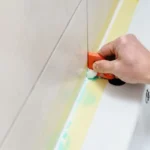Designing accessible bathrooms for elderly and mobility-impaired individuals, House decorationg tips, Property renovation design advice
Designing Accessible Bathrooms for Elderly and Mobility-Impaired Individuals
24 Oct 2023
Designing a bathroom for the elderly and individuals with mobility issues in England is a task that requires meticulous attention to detail and a thorough understanding of specific needs and regulations.
Creating a well-designed, accessible bathroom is not just about meeting legal requirements but also about prioritising safety, convenience, and user comfort. In this comprehensive guide, we’ll explore each crucial aspect of designing an accessible bathroom in England, where adhering to legal standards and ensuring user well-being are paramount.
1. Legal Requirements and Regulations
When embarking on the journey to design an accessible bathroom, your starting point should be a deep understanding of the legal landscape governing bathroom accessibility in England.
The Building Regulations 2010, particularly Approved Document M (Access to and Use of Buildings), serve as the cornerstone for ensuring your bathroom aligns with national accessibility standards. These regulations set the framework for creating spaces that are inclusive and accessible to all.
2. Entry and Exit
A fundamental aspect of bathroom accessibility is providing a step-free entry. This means eliminating any raised thresholds that may hinder mobility. For individuals using wheelchairs or other mobility aids, it’s essential to consider installing a ramp with a gentle slope. This ensures smooth wheelchair access. Furthermore, the entry point should be adequately wide to allow easy passage for individuals with varying mobility levels.
3. Wider Doorways
Widening the bathroom doorway is of paramount importance. An 800mm minimum width is recommended, as this wider entrance allows for easy wheelchair maneuverability. It’s crucial to ensure that the bathroom doorway is wide enough to accommodate the turning radius of a wheelchair, making it a cornerstone of bathroom accessibility.
4. Non-Slip Flooring
Safety is a top priority in accessible bathrooms, particularly in areas prone to water exposure. Non-slip flooring is imperative to minimise the risk of slips and falls. You should choose flooring materials specifically designed for their non-slip properties. In cases where existing flooring cannot be replaced, applying a non-slip coating is a practical solution to enhance safety.
5. Grab Bars and Handrails
Proper placement of grab bars and handrails is crucial in ensuring that individuals with mobility issues can safely navigate the bathroom. These should be strategically positioned near the toilet, shower, and bath areas. The choice of materials for these bars is equally important; they should be durable and easy to grip, providing individuals with the necessary support and balance.
6. Accessible Sink and Vanity
Selecting the right sink and vanity options is vital to ensure accessibility. A wall-mounted or pedestal sink design is recommended as it provides adequate clearance for wheelchairs. Additionally, it’s essential to ensure that the space beneath the sink is free from obstructions, allowing for ample knee clearance.
7. Roll-In Shower
A roll-in shower is a notable feature in an accessible bathroom. It should be equipped with a built-in or fold-down bench, making it easier for individuals with limited mobility to shower comfortably. Installing a handheld showerhead enhances user convenience. Moreover, for safety, anti-scald controls are essential as they prevent sudden temperature fluctuations.
8. Comfort Height Toilet
Opting for a comfort height toilet is a decision that greatly impacts the bathroom’s overall usability. These toilets are higher, making it easier for individuals with mobility challenges to sit down and stand up. Adequate space should be available around the toilet to ensure easy access.
9. Anti-scald and Temperature Control
To enhance safety, it’s important to install anti-scald faucets and temperature control valves. These features help prevent hot water burns, which are especially important for individuals who may have reduced sensitivity to temperature changes.
10. Accessible Storage
Accessible bathrooms should be equipped with well-designed storage solutions. Shelves and cabinets should be positioned at a convenient height, allowing users to access personal items without strain. The design of storage solutions should minimise the need for overreaching or bending, ensuring user comfort and safety.
11. Good Lighting
Adequate and well-placed lighting is essential for visibility, especially for those with visual impairments. Proper lighting should be evenly distributed, glare-free, and easy to operate. Consider the installation of motion-sensor lighting for added convenience, ensuring that individuals can move around the bathroom with ease.
12. Emergency Pull Cords
For care homes or assisted living facilities, installing emergency pull cords or alarms is a critical safety measure. These devices are vital for quickly summoning assistance in case of accidents or falls. Staff members should receive proper training on their use to ensure a swift response when needed.
In addition to pull cords, having access to a direct helpline for seniors who fall can further enhance safety. Such helplines provide immediate assistance and reassurance, ensuring seniors receive timely support in emergencies whether they are at home or in a care facility. This extra layer of protection can significantly reduce the risks associated with falls while offering peace of mind to both seniors and their families.
13. Easy-to-Use Fixtures
Select fixtures with large, easy-to-grasp handles and faucets. Lever handles, for example, are often preferred for their simplicity and ease of use. The operation of fixtures should be designed with minimal effort in mind, ensuring that individuals with various levels of mobility can use them comfortably.
14. Colour Contrast
Utilising colour contrast as a visual aid for individuals with visual impairments is a thoughtful design consideration. Ensure that fixtures, walls, and floors offer noticeable differentiation, making it easier for users to identify and navigate the bathroom. Colour contrast is a practical means of enhancing safety and usability.
15. Personalisation
Individual needs can vary significantly among those with mobility issues. Therefore, a truly accessible bathroom should allow for personalisation. Consider features such as adjustable showerheads, handheld shower wands, or specialised seating based on the specific user’s requirements. It’s essential to involve the end-users and healthcare professionals in this customisation process to ensure the bathroom meets their unique needs.
16. Consult a Professional
Engaging with experts in architecture, interior design, or accessible design is invaluable in the process of designing an accessible bathroom. These professionals can ensure that your bathroom not only complies with legal regulations but also meets the unique requirements of the end-users. This consultation guarantees that every detail, from the layout to the choice of fixtures and materials, is well-considered and in line with best practices in accessible design.
Accessible Bathrooms for the Elderly Design Summary
Incorporating these comprehensive elements into your bathroom design will result in a safe, comfortable, and fully accessible space for the elderly and individuals with mobility issues in England.
The key takeaway is that individual needs can be diverse, and collaboration with end-users and healthcare professionals throughout the design process is essential to create a truly inclusive and functional bathroom.
By adhering to legal standards and prioritising user well-being, you can create a bathroom that enhances the quality of life and independence for those with mobility challenges.
Comments on this guide to Designing Accessible Bathrooms for the Elderly and Mobility-Impaired article are welcome.
Bathrooms
Bathrooms Posts
Bathroom Flooring Best Options Guide
Top ways to upgrade and update your bathroom
Buildings
Residential Architecture Articles – selection:
Comments / photos for the Designing Accessible Bathrooms for Elderly and Mobility-Impaired page welcome


